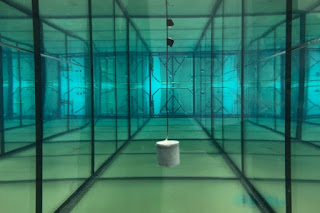Underwater Internet of Things
MIT's Underwater Sensor Network to Take the Ocean's Pulse
Powered Solely by Sound Waves
To investigate the vast unexplored areas of the oceans, MIT engineers are building a submerged network of interconnected sensors that send data to the surface. It's an underwater internet of things to monitor temperature changes from climate change, ocean pollution and marine life over long time periods. The MIT team has invented a battery-free sensor, powered by sound waves. The device can monitor the ocean environment at great depths over long periods of time with no battery. The submerged system uses the vibration of piezoelectric materials to generate power and send and receive data.
Underwater Communications System
This MIT invention appears to be a major breakthrough. Up until now, the difficulty of deploying deep water sensors to study ocean conditions has been greatly limited by their battery life. It's very difficult to change batteries at great depths. The MIT solution is an underwater communications system with two components: the seabed sensor and a transmitter/receiver located on the ocean surface or on the shore.
Acoustic Waves
Here's how it works. The transmitter sends an acoustic wave to the sensor, which causes the piezoelectric material in it to vibrate and generate an electric current. The sensor uses the energy to send a wave back or not to the receiver. That generates a data stream of 1's and 0's. According to the team, once you can transmit 1's and 0's, you can send any information. They've innovated a system that communicates with underwater sensors through sound waves, generates energy and sustains the sensor system, which MIT envisions as an interconnected network.
 |
| Source: MIT |
Powered Solely by Sound Waves
To investigate the vast unexplored areas of the oceans, MIT engineers are building a submerged network of interconnected sensors that send data to the surface. It's an underwater internet of things to monitor temperature changes from climate change, ocean pollution and marine life over long time periods. The MIT team has invented a battery-free sensor, powered by sound waves. The device can monitor the ocean environment at great depths over long periods of time with no battery. The submerged system uses the vibration of piezoelectric materials to generate power and send and receive data.
Underwater Communications System
This MIT invention appears to be a major breakthrough. Up until now, the difficulty of deploying deep water sensors to study ocean conditions has been greatly limited by their battery life. It's very difficult to change batteries at great depths. The MIT solution is an underwater communications system with two components: the seabed sensor and a transmitter/receiver located on the ocean surface or on the shore.
Acoustic Waves
Here's how it works. The transmitter sends an acoustic wave to the sensor, which causes the piezoelectric material in it to vibrate and generate an electric current. The sensor uses the energy to send a wave back or not to the receiver. That generates a data stream of 1's and 0's. According to the team, once you can transmit 1's and 0's, you can send any information. They've innovated a system that communicates with underwater sensors through sound waves, generates energy and sustains the sensor system, which MIT envisions as an interconnected network.
%20(1)%20(1)%20(3)%20(2)%20(2).jpg)


Comments
Post a Comment